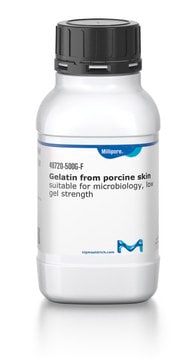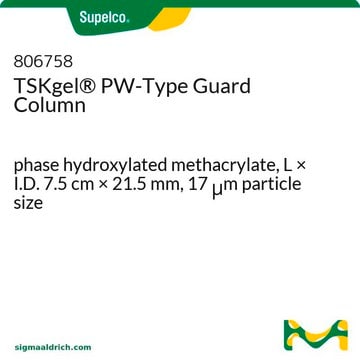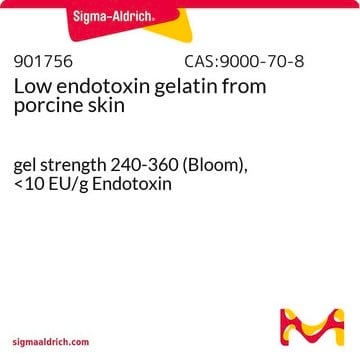G2500
Gelatina from porcine skin
gel strength 300, Type A
About This Item
Productos recomendados
biological source
Porcine skin
type
Type A
assay
70-90% (biuret)
form
powder
technique(s)
cell culture | mammalian: suitable
gel strength
~300 g Bloom
solubility
H2O: soluble 50 mg/mL
¿Está buscando productos similares? Visita Guía de comparación de productos
General description
Application
- for coating glass-bottomed plates for culturing A375 cells and in gelatin degradation assay
- for coating glass slides in the histological studies with brain sections
- in the synthesis of gelatin methacrylate (GelMA) prepolymer for encapsulating cells on to 3D printed hydrogels
- to prepare thiol-functionalized gelatin (GelSH) hydrogel for 3D projection bioprinting
Biochem/physiol Actions
Components
Caution
Preparation Note
Storage Class
11 - Combustible Solids
wgk_germany
nwg
flash_point_f
Not applicable
flash_point_c
Not applicable
ppe
Eyeshields, Gloves, type N95 (US)
Certificados de análisis (COA)
Busque Certificados de análisis (COA) introduciendo el número de lote del producto. Los números de lote se encuentran en la etiqueta del producto después de las palabras «Lot» o «Batch»
¿Ya tiene este producto?
Encuentre la documentación para los productos que ha comprado recientemente en la Biblioteca de documentos.
Los clientes también vieron
Artículos
Discussion of synthetic modifications to gelatin, improving the three-dimensional (3D) print resolution, and resulting material properties.
Uncover properties and applications of the cysteine protease papain and find inhibitors, substrates, and other papain products.
Uncover properties and applications of the cysteine protease papain and find inhibitors, substrates, and other papain products.
Uncover properties and applications of the cysteine protease papain and find inhibitors, substrates, and other papain products.
Nuestro equipo de científicos tiene experiencia en todas las áreas de investigación: Ciencias de la vida, Ciencia de los materiales, Síntesis química, Cromatografía, Analítica y muchas otras.
Póngase en contacto con el Servicio técnico












